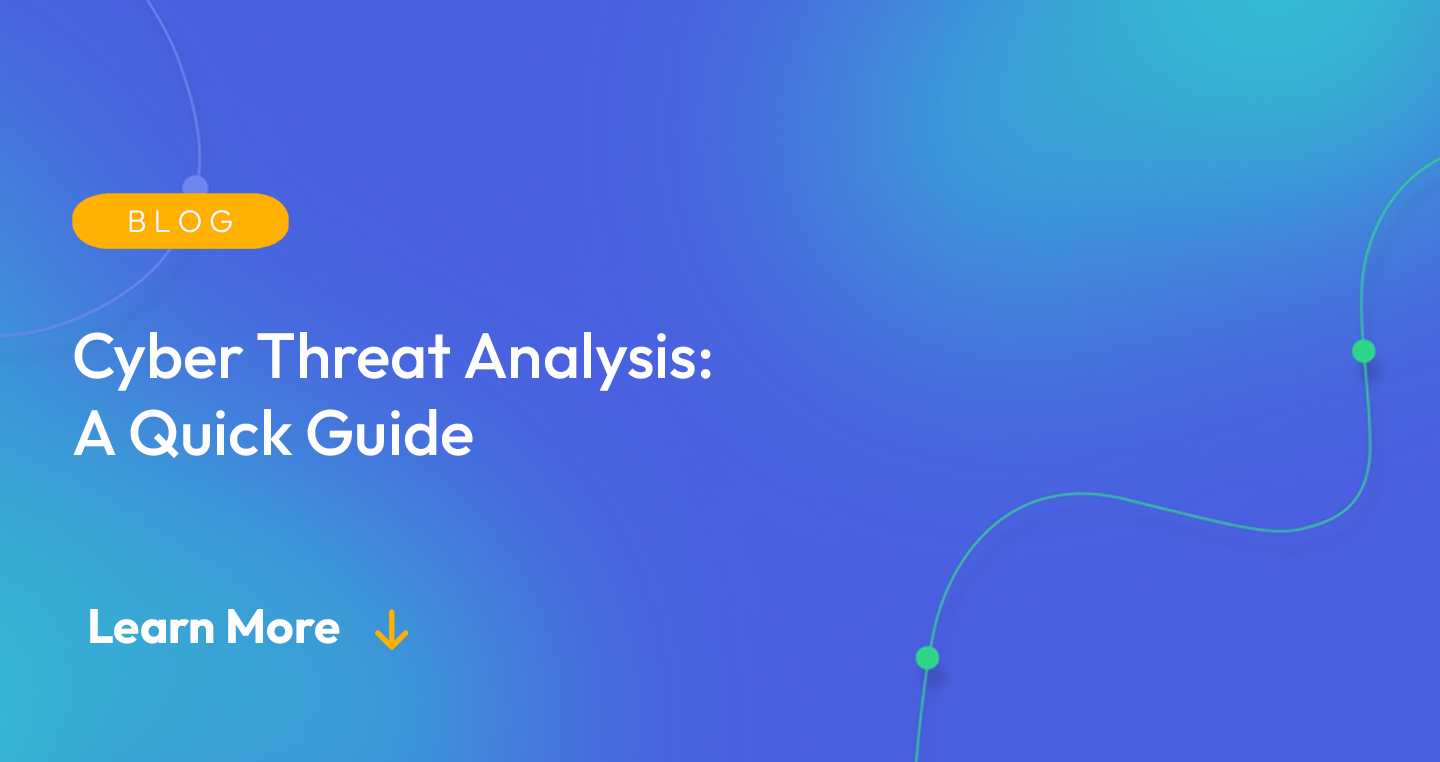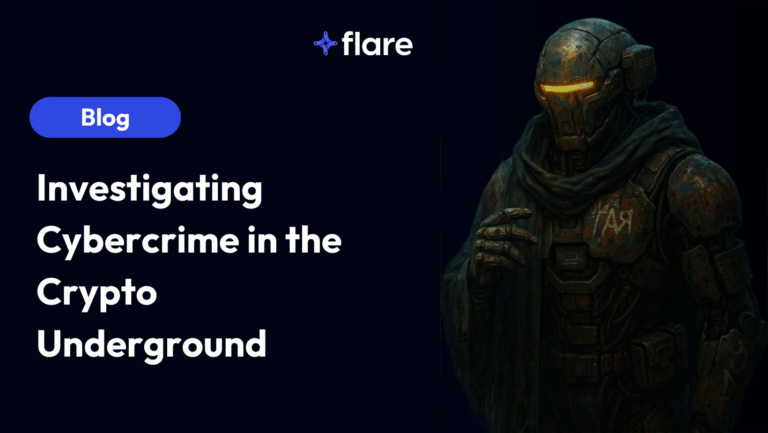
The need for effective cyber threat analysis – a critical process that involves identifying, investigating, and evaluating potential threats to maintain the integrity of our digital environments, is integral to cybersecurity. For businesses harnessing the power of Software as a Service (SaaS) platforms, particularly those in the field of cyber threat intelligence, comprehending and implementing effective threat analysis methods is paramount.
Threat intelligence is traditionally seen as a “low ROI” security technology, with many security teams entirely foregoing CTI programs. At Flare we believe that this view is fundamentally mistaken. Threat intelligence can provide the backbone for a security program.
Understanding Cyber Threat Analysis: The Basics and Importance
As we continue to leverage technology for our organizational and personal needs, cybersecurity becomes a critical concern. An essential component of comprehensive cybersecurity measures is cyber threat analysis. But what is it, and why is it crucial?
What is Cyber Threat Analysis?
Cyber threat analysis is a process that involves the identification, assessment, and understanding of potential cyber threats that could harm a system, network, or an organization.
It combines aspects of data analysis, security intelligence, and forensics to evaluate and prioritize potential threats. This evaluation takes into account not just the likelihood of a particular threat eventuating, but also its potential impact.
As cyber threats continue to evolve in complexity and sophistication, organizations need to stay ahead of potential risks. Reactive measures, once a threat has materialized, are often costly and can damage a company’s brand irreparably. Proactive measures like cyber threat analysis, on the other hand, help in anticipating and mitigating threats before they can wreak havoc.
Cyber threat analysis is the key to effective cybersecurity through:
- Identifying patterns of suspicious behavior
- Discovering security gaps
- Predicting likely future attacks based on historical data
- Discovering threat actors targeting your organization on the dark web
- Understanding the methods employed by potential threat actors
In a world where cyber threats are not a matter of ‘if’, but ‘when’, mastering the art and science of cyber threat analysis becomes vital for any organization navigating the digital environment.
The 5 Core Components of Effective Cyber Threat Analysis
A robust and effective cyber threat analysis process incorporates several integral components. Each of these contributes to creating a comprehensive picture of an organization’s threat landscape, enabling security teams to respond swiftly and decisively.
Here are the five core components that shape a robust cyber threat analysis:
1. Threat Intelligence Gathering
The first step in the analysis process involves gathering data about potential threats. This data can come from multiple sources, including internal system logs, open-source intelligence (OSINT), commercial threat intelligence feeds, and industry reports. The aim is to aggregate as much relevant data as possible to uncover potential threat patterns and indicators of compromise (IoCs).
The core of threat intelligence isn’t just collecting a lot of data, it’s knowing what new sources are needed for collection, building contextualization in, and most importantly deriving actionable security data from complex technical events. For example, a company that’s been collecting the same intel for the past five years will have missed the emergence of stealer logs, a critical new threat that enables malicious actors to bypass 2FA and MFA controls.
Another poignant example is the advent of Telegram as a major part of the cybercrime ecosystem. Teams that only collect from Tor sites can miss huge amounts of context and high-value intelligence by skipping this crucial source of data.

2. Threat Evaluation
Once data is gathered, it’s time for evaluation. This phase involves understanding the nature of collected threat data, including the tactics, techniques, and procedures (TTPs) employed by threat actors. By evaluating the potential severity and likelihood of each threat, organizations can prioritize their response efforts.
Having trained teams that not only understand how to evaluate technical data, but also understand how to translate that information into business terms and risk based analysis is absolutely essential. Many organizations have incredible technical teams, but those teams often miss the mark in conveying risk information.
3. Contextual Analysis
Not all threats pose the same level of risk to every organization. The contextual analysis stage involves understanding how a particular threat relates to your specific organizational context.
This could involve considering your:
- industry sector
- the nature of your data
- your digital infrastructure
- even geopolitical factors
Most important is understanding the context of a threat within the broader context of your business. For threat intelligence, context is everything. For example let’s take a piece of data without context:
“North Korea launches dozens of missiles amid soaring tensions”
If you read that news headline without any prior knowledge about North Korea’s behavior, where they launched the missiles or any other data you would rightfully be incredibly concerned. However, if you were provided with the context that this has happened before, they launched them into the sea, and no lives were lost, your concern would likely decrease.
4. Predictive Analysis
With a sound understanding of potential threats and their relevance to your organization, the next step is predictive analysis. Using historical data and machine learning algorithms, predictive analysis helps forecast likely future threats. It’s a proactive strategy that empowers organizations to prepare for, and even prevent, potential attacks.
Predictive analytics is particularly valuable in cases where you have a lot of data.
5. Threat Mitigation Strategy Development
The final stage of effective cyber threat analysis is the development of mitigation strategies. Based on the collected intelligence and predictive analysis, security teams can formulate a plan to protect their organization’s digital assets. This could involve anything from:
- Strengthening security protocols
- Applying software patches
- Implementing more advanced cybersecurity technologies
By integrating these core components into your cyber threat analysis, you can ensure that your organization stays ahead of evolving cyber threats.
It’s not just about dealing with cyber threats, but dealing with them intelligently and strategically. The peace of mind that comes from knowing you’re prepared for whatever the digital landscape might throw at you is invaluable.
Step-by-Step Guide: Executing Cyber Threat Analysis
Cyber threat analysis is a proactive approach that bolsters your organization’s cybersecurity measures. The goal is to understand, anticipate, and mitigate potential threats before they can cause harm. To execute this effectively, consider the following step-by-step guide:
1. Identify Potential Threats
This involves gathering threat intelligence from a variety of sources like
- Log files
- Threat intelligence feeds
- Industry reports
You should collect as much information as possible on potential threats, focusing on their signatures or indicators of compromise (IoCs). This step often includes using specialized software tools to automate the collection of threat intelligence.
2. Analyze Collected Intelligence
Once you’ve gathered data, start analyzing it to understand the potential threats. Look for patterns and connections in the data, and identify the tactics, techniques, and procedures (TTPs) that threat actors are using. This helps to gain a clear understanding of the threat landscape and the risk each threat poses to your organization.
3. Evaluate the Relevance of Threats
Every organization has unique vulnerabilities. Evaluate how the identified threats might impact your specific context, including your:
- Industry
- Data sensitivity
- Digital infrastructure
This step requires an in-depth understanding of your organization’s unique digital environment and potential vulnerabilities.
4. Prioritize Threats
Based on your evaluation, prioritize the threats according to their potential impact and the likelihood of their occurrence. Prioritizing helps to focus your security efforts, ensuring that you address the most significant threats first.
5. Predict Future Threats
Use the analysis to anticipate future cyber threats. This involves assessing current trends, historical data, and emerging technologies. Predictive analytics tools can aid in identifying patterns that might indicate future cyber threats.
6. Develop Mitigation Strategies
With a clear understanding of your threat landscape, you can then create strategies to mitigate identified threats. This involves:
- Remedying identified vulnerabilities
- Strengthening your defense systems
- Formulating response protocols in the event of a security breach
7. Implement and Review:
Finally, implement the devised strategies and consistently review their effectiveness. Cyber threats continually evolve, making it crucial to keep your threat analysis and mitigation strategies dynamic and adaptive. Regularly reviewing and updating your strategies ensures that you’re prepared for new and emerging threats.
Effective cyber threat analysis is a continuous process. It’s a cycle of:
- Collecting data
- Analyzing it
- Predicting threats
- Developing, implementing, and reviewing strategies
This ongoing process ensures that your cybersecurity measures stay robust and up-to-date in the face of an ever-evolving threat landscape.
Leveraging SaaS Platforms for Advanced Cyber Threat Analysis
As organizations continue to confront an ever-expanding digital threat landscape, SaaS (Software as a Service) platforms have emerged as powerful allies. These platforms provide advanced tools and services that can significantly enhance the efficacy of cyber threat analysis. Here’s how they play a crucial role:
Automated Data Collection
SaaS platforms can automate the process of collecting vast amounts of data from numerous sources, such as network logs, cloud environments, and even external threat intelligence feeds.
This allows organizations to gather a comprehensive data set that forms the basis of a detailed and accurate threat analysis.
Sophisticated Analysis Tools
By harnessing advanced technologies like AI and machine learning, SaaS platforms can analyze the collected data in depth. They can identify patterns, detect anomalies, and flag potential threats that might otherwise be missed. This allows for more precise and comprehensive threat detection.
Contextual Insights
Through the incorporation of contextual intelligence, these platforms can evaluate the relevance of detected threats based on an organization’s unique digital environment and risk factors. This contextual understanding ensures that companies can prioritize and address the threats most relevant to their particular circumstances.
Real-Time Monitoring
SaaS platforms provide continuous, real-time monitoring of an organization’s digital assets. This enables immediate detection of any suspicious activities, providing the opportunity for a rapid response before any substantial damage can occur.
Scalability
SaaS platforms are designed to scale with the needs of an organization. As the digital environment of a business grows, these platforms can continue to provide robust threat analysis capabilities, ensuring that cybersecurity measures remain effective regardless of the organization’s size.
Integration Capabilities
SaaS platforms can seamlessly integrate with existing security infrastructures and tools, creating a unified and coordinated approach to threat detection and analysis. This helps to eliminate potential blind spots and provides a comprehensive overview of an organization’s security posture.
Continuous Updates
With SaaS platforms, organizations can benefit from regular updates and enhancements. As cybersecurity threats evolve, the SaaS providers update their platforms to counter new strategies and techniques employed by cybercriminals.
Leveraging a SaaS platform for cyber threat analysis can provide organizations with sophisticated, real-time, and scalable cybersecurity solutions. These platforms not only streamline the process of threat analysis but also enhance its effectiveness, allowing businesses to stay ahead of potential cyber threats and protect their critical digital assets effectively.
However, choosing the right platform involves careful consideration of your organization’s specific needs, the features offered by the platform, and its compatibility with your existing security infrastructure.
Cyber Threat Analysis and Flare
Navigating the complex and ever-evolving landscape of cybersecurity is an imperative for businesses worldwide. Central to this effort is the strategic application of cyber threat analysis, an essential tool that allows organizations to identify, assess, and counter potential threats proactively.
Flare provides the minimal viable information to customers so your CTI team can act quickly, without worrying about the noise. Sign up for a free trial with Flare to learn more.





